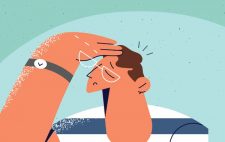The internet is filled with tips for thriving through your period: During the first part of your cycle, you should do cardio. Eat more asparagus when you’re ovulating. Start new projects once you’ve finished your period. But can we actually hack our cycles? We spoke with Dr. Kristina Williams of The Ripa Center in Voorhees to set the record straight on cycle syncing.
It’s just a phase
You might think your menstrual cycle has two parts: bleeding and not bleeding (ovulation too if you’re paying a little more attention). But it turns out our cycle is a bit more complicated than that.
“The first phase of a menstrual cycle is the Follicular phase – when there are higher levels of estrogen than progesterone in the body,” says Williams. “The phase lasts about 14 days and peaks at ovulation.”
This is when you’ll most likely feel what you consider “normal.” It’s also when you’ll bleed, at least for the first 3-7 days. But once you start ovulating – which overlaps with the Follicular phase and the following phase (the Luteal phase) – your estrogen levels take a sharp dip. You might feel that as a change in mood.
“A lot of women will say, ‘I can feel when I’m ovulating,’ because they feel that change in mood,” Williams says. “You’ll be hit with moodiness
again at the end of your cycle, when your hormones change again.”
The next phase is the luteal phase, when your progesterone levels increase and estrogen drops. “Your energy requirements are higher during these 14 days because your body is preparing to support a pregnancy,” Williams says. “Then, your hormones shift again and you start menstruating. And that’s the full cycle.”
When does the hacking start?
If you’re thinking, “this sounds confusing,” you’re not alone. But the good thing about being a woman is that there’s tons of research into how our bodies work. Just kidding, there’s pretty much zero factual evidence to explain what’s going on with our periods – thanks to decades of a lack of interest and funding in women’s health.

Dr. Kristina Williams of The Ripa Center in Voorhees
And that means getting a definitive answer to the question “is cycle syncing real?” is very difficult. “We don’t even know exactly how our hormones affect our moods, because there’s so little research done on periods,” Williams says. “The moodiness might be caused by the hormone that spikes or it might be the actual shifting in hormone levels that prompts our symptoms.”
While there’s no factual data to back up how to hack your menstrual cycle, it doesn’t mean there’s nothing to work with. A Mediterranean diet – a plant-centered diet that’s low in carbs and high in fats – has been proven to decrease incidences of pain from periods, says Williams. And exercising throughout your cycle can have a positive effect on your mood.
The first step for everyone, says Williams, is tracking your period. Williams recommends tracking your period and your symptoms for about 3 to 6 months. “The phases should be similar every month, though one thing that may vary is how much they peak,” she says. “And there are some factors that could affect your cycle, like calorie restriction or being overweight, which can both lead to irregular periods.”
Birth control will also affect these phases, and by “affect,” we mean pretty much eradicate. “The way birth control works is by adding hormones to the body to keep the levels at a steady state,” Williams says. “Then it goes to the placebo, and that hormone drop is what starts the period. So if you’re on birth control, your experience will be different.”
The best way to hack your period is by talking to your doctor, Williams says. But make sure you tell them exactly why you’re coming in. “Most physicians aren’t taught what affects our periods,” she says. “But we learn about it on our own and look into it more and more as patients come to us and ask about it. And if you come in specifically to talk about that, we will prepare beforehand to be as helpful as possible.”









